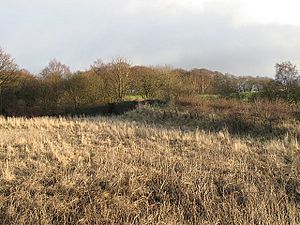Drumpellier Country Park facts for kids
Drumpellier Country Park is a fun country park located near Coatbridge, in North Lanarkshire, Scotland. It used to be a private estate, but in 1919, it was given to the town of Coatbridge to be a public park. In 1984, it officially became a country park.
The park is huge, covering about 500 acres (2 km²)! It has two natural lochs (lakes), one of which is a special protected area called a Site of Special Scientific Interest (SSSI). You'll also find open grasslands, woodlands, and lowland heath here. The Monkland Canal runs along the south side of the park.
Both the lochs and the canal are home to many water birds. You can see resident birds like swans and mallard ducks, and also birds that visit in winter. The areas around the lochs and in the woods are full of wild plants. The woodlands are also great for spotting different birds, small wild animals, and many kinds of fungi.
The lochs at Drumpellier were formed a long, long time ago, at the end of the last ice age. As a giant glacier (a huge sheet of ice) moved across Scotland, it created these small pockets of water, known as "kettle ponds." The path around the loch is about 1 mile (1.6 km) long and is perfect for bikes.
Since July 2019, the park has been a popular spot for the Drumpellier Country Parkrun, a free, weekly 5k event.
What's in a Name?
The name Drumpellier might come from an old language called Common Brittonic. It could mean something like "a fort" or "a hill-fort." Another idea is that the name means "ridge where the wheat is stored." This makes sense because the area was once used for farming.
A Look Back in Time
People have lived in and around Drumpellier for thousands of years! Tools from the Stone Age have been found near Woodend Loch. Lochend Loch (which locals often call Drumpellier Loch) once had a crannog. A crannog was an ancient home built on stilts in the water, used by people in the Iron Age for safety. You can still see where the crannog was on Lochend Loch, marked by small colored buoys.
During the Middle Ages, Drumpellier was a farm belonging to the monks of Newbattle Abbey. This is why the area around it was historically called Monklands. The Monkland Canal at the south end of the park reminds us of the area's industrial past. It was an important waterway connecting to Glasgow and the Clyde, which led to the sea.
Drumpellier House and Its History
The Drumpellier estate was bought in 1735 by a wealthy tobacco merchant named Andrew Buchanan. He built the first part of Drumpellier House in 1736, and it was made even bigger in the 1740s and 1750s. More additions were made in the 1840s and 1850s.
Andrew Buchanan became the Lord Provost of Glasgow (like a mayor) in 1740. He made a lot of money from tobacco farms in Virginia, which were then part of the English colonies. He also owned many properties in Glasgow.
He played a part in history during the time of Prince Charles Edward Stuart (also known as Bonnie Prince Charlie). Even though he didn't support the Prince, Andrew Buchanan helped convince the Jacobites not to destroy Glasgow, and he managed to lower the amount of money they demanded from the city.
The Drumpellier estate was given to the town of Coatbridge in 1919. In the 1920s and 30s, many people from Glasgow would travel by tram to Drumpellier to camp in the park on weekends. Sadly, Drumpellier House was taken down in the 1960s. Today, the estate is a beautiful Country Park and a golf course.
Sir James Stirling, a British naval officer, was born in Drumpellier in 1791. He was very determined and convinced the British Government to start the Swan River Colony. He became the first Governor of Western Australia.


